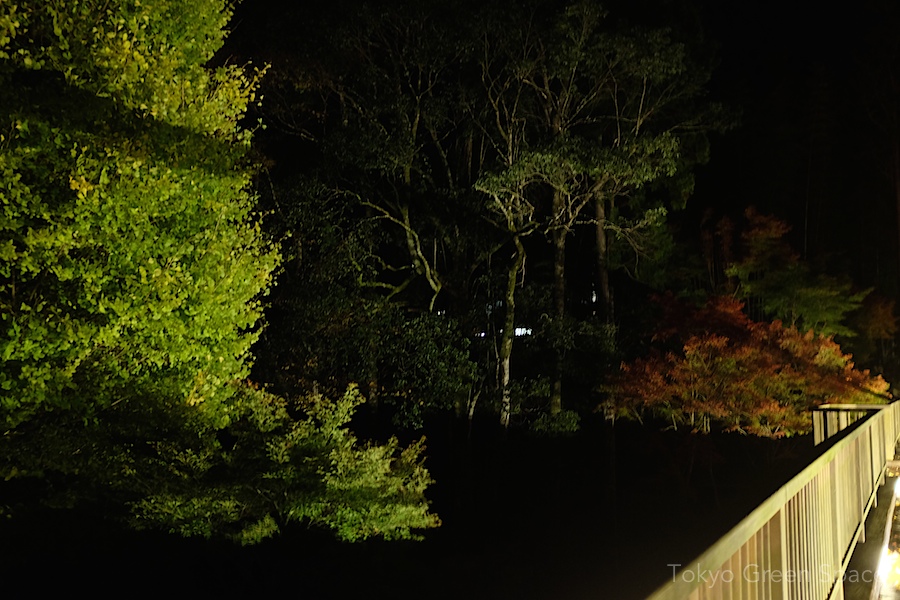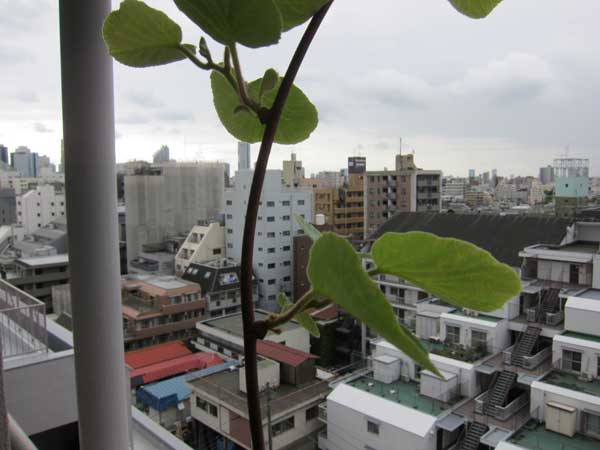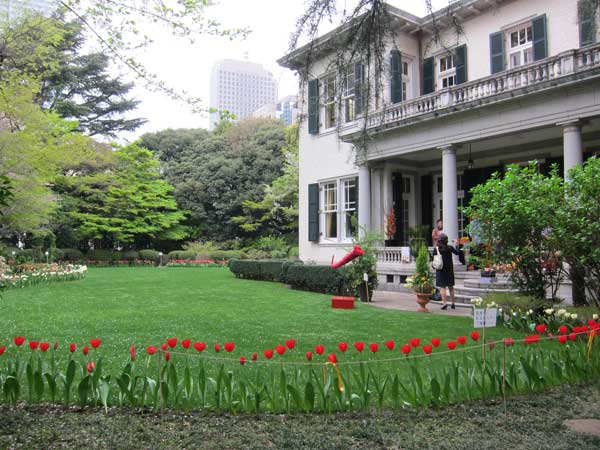
虹形の影が見えます。

夏、エアコンの上はベランダの庭で一番暑いところです。今そこに多肉サボテンを置きました。この陶芸の植木鉢は手仕事屋久家で作りました。
The balcony summer hotspot is the air conditioner, almost always on and blowing hot air. This summer, I’m enjoying succulents which seem fine on top, but probably not in front, of the a/c. They have fun colors, shapes, and even textures. The ceramics were made at Kuge Crafts.


This summer I up-sized the pot for this wonderful kanamemochi bush, so common in Tokyo. In spring the new leaves are red, and it’s very easy to prune the bush into a hedge or any shape you want. I want to use it as a screen for the washing machine or air conditioner.

キウイの葉はきれいな形です。春に、若葉がとても新鮮に見えます。キウイのフルーツのように、男性と女性の木がいるでしょうか。うちのベランダには一つだけしかないですが、たぶんどこか隣に違う性のキウイがあればいいです。
I love the shape of this kiwi vine’s leaves. They look so fresh and new. I am not sure if you need a male and female kiwi to produce fruit. I hope one of our neighbors has the right sexed kiwi to activate ours!

4月13日と14日に、オランダの大使館の庭が一般公開されて、一万一千本のチューリップが見られました。チューリップはとてもきれいで、とても特別な場所です。毎年二回、一般公開されます。
Showing off 11,000 tulips specially planted, the Netherlands Embassy opens its gardens to the public on April 13 and 14. I was fortunate to go the first day, and see the splendid varieties of color, height, and shape before the rains started.
One of Tokyo’s oldest and most renowned garden maintenance firm expertly selected dozens of hybrids, created a grand walkway, and also integrated tulips into the main garden of the residence. Planning extended the season as long as possible, which I heard is about three weeks.
Amidst all the bright colors in this grand setting, I felt like I was in a mini-Keukenhof crossed with Gatsby’s home in West Egg. We caught a glimpse of two chefs working in the kitchen, which made me think this diplomatic outpost with 400 years of history is not so far from Downton Abbey.
If you have a chance, please go today, or in the fall on Culture Day when both the residence and garden are open to the public.



I love how these traditional Japanese pines in Shinjuku Gyoen are so meticulously pruned. On this clear winter day, I love how you can see the pine needles accumulating against the brown lawn. Three ladders, red traffic safety cones, helmets, and no doubt some great pruning shears.

日本庭園の剪定はカンペキです。東京体育館のような公共施設にもツツジが波の形にしてあって、木が高いプードルみたいです。ですから、そこで自然に生えたシュロを見て驚きました。ヤシは「外人」だから、大丈夫なのでしょうか。
Japanese garden maintenance is precise and skilled, even in public facilities. Because of this, I was all the more surprised and delighted to see a self-sown shuro palm disrupting this heavily manicured and idealized landscape behind the Tokyo Metropolitan Gymnasium. The azaleas on the slope are pruned to suggest waves, and the trees pruned as if they were posh poodles.
Maybe because it’s a palm tree, this intruder is allowed to thrive.

茂みの波の形は、角張った建物に対照しています。
The bushes’ wave shape makes a nice contrast with the angular buildings tightly packed.

この停留所は東京グリーンスペースの比喩です。昔、公共スペースは計画されたことがありません。今は都市の指導者と官僚が車中心社会とメガ開発を支えすぎます。3.11の前、政府が悪くても、東京はいい都市だと思いました。3.11の後、無能な指導者は危ないと思います。
年末が近づくにしたがって、もっと生きている都市をどう作れるかと考えています。
This sidewalk and street have nearly no visible plants. Yet anonymously gifted bus stop chairs are very Tokyo and very much in the spirit of Tokyo green space. Reacting to a lack of infrastructure– no shelter and no seating– neighbors simply recycle and re-use stuff from their homes and share it with neighbors in a public space.
Few designers could have coordinated this unlikely mix of colors, fabrics, and shapes. Its aesthetic arises from its spontaneous appearances. Is this the most beautiful, practical, or ideal solution to the lack of infrastructure? Probably not, although it reflects generosity and concern for others in shared spaces.
I have been writing about Tokyo green space for a while, ever since moving here three years ago. Tokyo is surprisingly green and livable despite the complete absence of planning for public open space, from its rise as Japan’s Edo capitol in the 1600s through the 20th century’s natural and man-made calamities that twice obliterated the city.
Tokyo has such forward-looking urban features like walkable small streets dominated by pedestrians and bicyclists. But these vital paths exist not because of contemporary Tokyo’s good planning, but because the bureaucracy still in the thrall of automobile infrastructure and mega-developments hasn’t had the chance to alter them.
Documenting Tokyo green space has been a way for me to understand the life of this city. The grass-roots reclaiming of public space certainly increases the city’s appeal. But, post 3.11, I also now wonder if the residents haven’t demanded enough of the city leaders. We now know more clearly the dangers of leaving vital decisions to reckless and outdated politicians and bureaucrats.
As this difficult year ends, I wonder what all of us can do to create a more alive city.

I am a big fan of Okinawa morning glory and Edo morning glory. The Edo ones typically have a white border and stripes, and come in many colors. They’re very showy, a good size for domestic spaces, and they evoke Tokyo history. The Okinawa morning glory is a deep blue perennial, and quickly spreads and covers much more space. Both share a distinctive leaf shape.


花見の季節は終わり、最後の夜の花びらの写真です。
I love this multi-petal and super-pink cherry tree growing outside my apartment building. At night, it is magical against the clouds and electric power lines. I like that the tree has been trimmed into a lollipop shape. The sight of the petals pooling up in the gutter is also strangely captivating: so pink and so transient.
Fortunately, once cherry trees have finished blooming, there is a burst of spring flowers: azalea, dogwood, lilac, iris, jasmine, and soon roses.


史火の教室で盆栽用の植木鉢を作っています。
In the aftermath of the tsunami and nuclear crisis, it seems many have retreated into their homes and offices. Now more than ever is the time to go outside, interact with neighbors, and support your local small businesses in Tokyo: restaurants, vegetable shops, artisans, and creative studios.
I started making a series of bonsai pots at the ceramic studio Shiho. Here’s the basic process:
Step 1: Create shapes. Form clay into a block, slice off slabs, place slabs around molds covered in cheese cloth, remove, and let sit to harden.
Step 2 (between 2 days and 2 weeks after creating shapes): Trim the tops and sides. Add holes and channels for drainage. Carve name in bottom.
Step 3: First firing.
Step 4: Add glaze. I will leave each pot partly unglazed to show off the clay.
Step 5: Second firing.
The whole process may take 6 to 8 weeks, depending on the studio’s firing schedule and my free time.


一月の松は一番きれいだ。剪定がとてもよくされている。
With skilled pruning, Japanese gardens have stunning pine trees, often at their most beautiful in January. The needles are straight, and the branches are pruned over many years to wiggle. Tthe canopy is at both airy and precisely defined. You can find a beautiful pine tree at almost every traditional Japanese garden and also paired with modern architecture and as bonsai. This tree is by the pond at the Okidomon Gate at Shinjuku Gyoen (大木戸門)
